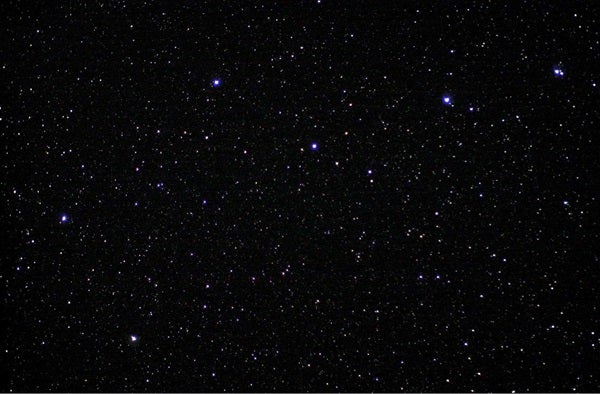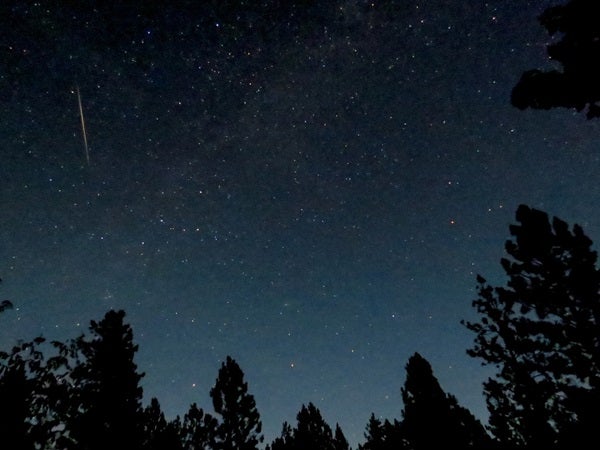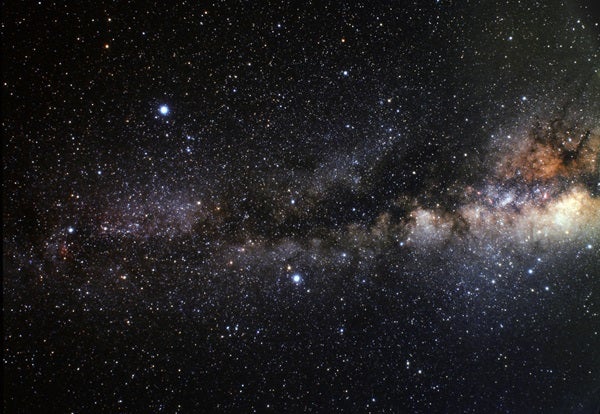• Look high in the northwest after darkness falls this month, and you’ll be greeted by the familiar sight of the Big Dipper. The Dipper is the most conspicuous asterism — a recognizable pattern of stars that doesn’t form a complete constellation shape — in the entire sky. It forms the body and tail of Ursa Major the Great Bear. Use the Pointers, the two stars at the end of the Dipper’s bowl, to find Polaris, which lies due north for everyone north of the equator. Polaris marks the end of the Little Dipper’s handle. On June evenings, the relatively faint stars of this dipper arc directly above Polaris.
Saturday, June 25
• Neptune rises a few minutes past midnight this week and climbs more than 30° above the southeastern horizon by the start of morning twilight. The magnitude 7.9 planet lies in Aquarius, some 0.5° southeast of 4th-magnitude Lambda (l) Aquarii. You’ll need binoculars to spy Neptune and a telescope to see its blue-gray disk, which spans 2.3″.
Sunday, June 26
• If ever there was a good time to track down Pluto, this is the night. The distant world passes just 2.7′ due south of the 3rd-magnitude star Pi (p) Sagittarii in northeastern Sagittarius, making the task of finding the dwarf planet much easier than usual. Pluto glows dimly at magnitude 14.1, however, so you’ll need an 8-inch or larger telescope to spot it visually.
Monday, June 27
• Last Quarter Moon occurs at 2:19 p.m. EDT. Look for it either before dawn this morning (when it lies among the background stars of southern Pisces and looks slightly more than half-lit) or after it rises around 1:30 a.m. local daylight time tomorrow (when it stands on the border between Pisces and Cetus and appears as a fat crescent).
• The typically minor June Boötid meteor shower occasionally reminds us of its presence. After decades of inactivity, the shower produced up to 100 meteors per hour in 1998. It then returned with about half that number in 2004. Although astronomers aren’t predicting an outburst this year, veteran observers know that the only way to be sure is to actually watch the sky. The shower peaks before dawn today, though any “shooting stars” will have to compete with the light of the Last Quarter Moon. The meteors appear to radiate from a point, called the “radiant,” located in the northern part of the constellation Boötes the Herdsman.
Tuesday, June 28
• For people who live near 35° north latitude, today marks the latest sunset of the year. Although Earth’s summer solstice and the Northern Hemisphere’s longest day occurred last week (on the 20th), latest sunset happens several days after and earliest sunrise several days before. The specific dates depend on your latitude, however — latest sunset at 40° north took place yesterday. In general, latest sunset occurs closer to the solstice the farther north you live.
Wednesday, June 29
• Observers of the outer solar system get their first good views of Uranus before dawn during June. The best time to look for it is shortly before twilight begins around 4 a.m. local daylight time. Uranus then lies nearly 25° high in the east among the background stars of Pisces the Fish. This morning, use binoculars to find the magnitude 5.8 planet about 4° west of 4th-magnitude Omicron (o) Piscium and 3° north of 5th-magnitude Mu (m) Psc. A telescope reveals Uranus’ blue-green disk, which spans 3.5″.
Thursday, June 30
• Mars remains a stunning sight all week. The Red Planet reaches its stationary point today, which means that its westward motion relative to the background stars of Libra comes to a halt and it begins moving eastward again. This westward push happens to stop just 20′ of the 8th-magnitude globular star cluster NGC 5897. Mars shines at magnitude –1.4 and appears almost due south and at its highest position in late twilight. When viewed through a telescope, Mars’ orange-red disk spans 16″.
Friday, July 1
• Brilliant Jupiter appears striking in the western sky as darkness falls and remains on display until nearly midnight local daylight time. The giant planet shines at magnitude –1.9 against the backdrop of southern Leo the Lion. Jupiter appears equally dazzling through a telescope, which reveals a wealth of atmospheric features on a disk that spans 34″. Tonight, observers also can see the giant moon Ganymede cross the planet’s northern hemisphere. The transit begin at 10:48 p.m. EDT (best for eastern North America) and lasts for more than three hours (giving western observers good views).
• The Moon reaches perigee, the closest point in its orbit around Earth, at 2:40 a.m. EDT. It then lies 227,411 miles (365,983 kilometers) away from us.
Saturday, July 2
• Perhaps no month better epitomizes summer in the Northern Hemisphere than July. And this month finds the season’s namesake asterism, the Summer Triangle, on prominent display. The trio’s brightest member, Vega in the constellation Lyra the Harp, stands nearly overhead shortly after midnight. The asterism’s second-brightest star, Altair in Aquila the Eagle, then lies more than halfway from the southeastern horizon to the zenith. Deneb, the luminary of Cygnus the Swan, marks the Summer Triangle’s third corner. Although it is this asterism’s dimmest star, it’s the brightest point of light in the northeastern sky.
Sunday, July 3
• Although Saturn reached its peak exactly one month ago, it remains a lovely sight. It is on display among the background stars of southern Ophiuchus from nightfall until the start of morning twilight. You can find the planet in the southeast during evening twilight and highest in the south around 11 p.m. local daylight time. Saturn continues to shine brightly, too, at magnitude 0.2. When viewed through a telescope, the planet measures 18″ across while its dramatic ring system spans 41″ and tilts 26° to our line of sight












